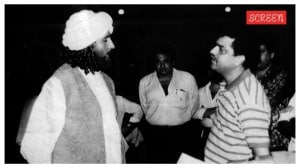Portrait of death as a celebrity
``The words of a dead man,'' wrote W.H. Auden,``are modified in the guts of the living''. We are here today, on the sunlit lawn of a new yea...

“The words of a dead man,” wrote W.H. Auden,“are modified in the guts of the living”. We are here today, on the sunlit lawn of a new year, still recovering from the hangover of a funeral party. The voices are turbulent, the images still vibrant, but we have not yet covered enough distance in memory to modify the dead man’s words. Doesn’t matter, think of the party. A carnival of death, staged on the mass mind, modified by the camera, choreographed by the media. The celebrity of 1997 was death. Its politics, its sociology, its humanity, its anxiety defined the Zeitgeist, semaphored our cynicism.
Perhaps the most beguiling details of this celebration are buried in a photograph we have not seen. A princess created by the angle of a zoom lens was ritually laid to rest by the camera itself. An exile from the palace, Princess Diana overwhelmed the Nineties by transforming herself into a photograph. She was an image in search of a backdrop, a Versace-clad Goddess in whom merged the melancholy of matrimony and the sociology of materialism. We never hesitated to seek out Every Man’s Diana in the shopping mall of New Age pornography. If she was clad in only a bikini, our beachfront voyeurism was fully naked. The paparazzo was the agent of our collective lust. When she was photographed to death, grief became operatic hysteria. Her posthumous picaresque as a post-modern Evita is an essay on the politics of emotions. Diana: An embalmed image that is capable of bursting the tear glands of the Camera Age.
Unfairly, the death of the Princess was pitted against the death of a nun by the moral mavens of the media. Was it any different, except in style? Mother Teresa, God’s pauper, practised her charity in the ghettoes of our mind. We rewrote her Catholic exceptionalism in the secular language of guilt. When Diana catwalked through that rare route between land mines and HIV viruses, she too was conquering our mental space of guilt. The Mother redeemed the Religion with a capital R; the Princess was the goddess of a new religion, founded and preserved by images. Both of them, the Mother and the Princess, epitomised aspiration and fantasy. And the flamboyance of messianism was as camera-friendly as the haute couture rebellion of the exiled fairy tale. Paradox: the pauper was given a royal funeral; to the Princess, it was a mass funeral. Death was a spectator game.
Death was a slogan, too. Tony Blair, socialism’s stalkerazzo, came out with the best one: People’s Princess. For the designer socialist, Diana in death offered a constituency of sorrow. It took a Tony Blair to give the famous spectral imagery of Marx a more realistic meaning. Ha, the idea of the dead is modified in the guts of the living salesman. The politician is a lame duck; he needs the divinity of death. For a few days last year, this simple truth lay naked in places as varied as London and Calcutta, Havana and Delhi. A First Lady in Calcutta seeking the definition of charity in a nun’s death; a socialist in London hawking the message of the compassionate socialite; a communist in Havana extending his redundancy by exhibiting the skeletons of a revolutionary; and a Congressman in Delhi taking refuge in the assassination of a Gandhi tell us, who was the paparazzo, who was the celebrity?
When you seek an answer through the morbid tales of 1997, strange patterns emerge. The similarity between Castro and Kesri is purely phonetic, nothing else, as is the case with communism and the Congress. But the distance between two leaders and their differing ideologies has been reduced by the politics of death, by manufactured national necrophilia. Che Guevara, the wildest of flower revolutionaries, the guerrilla Jesus, is an icon born out of a failed romance. The Cuban Revolution was his triumph; Castro was his campanero. Today he is the most favoured poster without the benefit of a Kalashnikov. Thirty years after his miserable martyrdom, Che has become a de-assembled skeleton in Havana, an exhibit for the orphans of revolution. Cuba may be a complete negation of Che’s romance, and Castro may be a leader of the bunker. The maximo lider, driven by the dread of mortality, sought the help of forensic science to keep the revolution going. Yet another modification of Marx’s spectral imagery. Lucky Che, he has a life outside the Swatch watch.
But Rajiv Gandhi has no such luck. It is unlikely that even his politically excavated memory will have any luck in the near future. After all, the script in India was thematically different. It was a case of death seeking death. For all practical purposes, 1997 marked the end of the Congress Century. Out in the sun, without a sheltering dynasty, the Congress, a party of Leaderless leaders, wanted a leader. Fair enough. The living ones were not qualified. They were all genetically programmed to be eternal sycophants. The widow is the unelected, but chosen, leader because she is the archetypal memory of the injustice of death. Like Che in Cuba, Rajiv Gandhi was India’s most popular “death” of 1997.
How come we have not yet got tired of death-watch? The Chinese may be able to give a culturally specific answer. They have waited and waited in the market, consuming Big Mac and mocking Bigger Marx, forgetting Mao’s thought and suffering Confucius’ wisdom, for communism’s greatest magician’s last journey. Deng Xiaoping at last got his appointment with Marx to play a game of bridge. In the land of antique ghosts, the new leader is today decolouring the Dengist cat. Death is not always a full stop. In Jiang Zemin’s China, it has provided another paragraph to the text of social capitalism. The prisoner disagrees, and Wei Jingsheng redeemingly endorses the disagreement. Though it is an altogether different matter that every culture-specific capitalist society cannot afford to celebrate death. The collapsed East Asian Tiger has already told us the truth.
A partial truth, in retrospect. We, the people, were a million animated objects, basking in the reflected glow of the funeral. A regenerative funeral. Death, in its celebrity avatar, marked the end of pretence: the living were not living. They had nothing to offer. Their failure in the art of national salvation was perhaps the source of the celebrity’s appeal. The cheerleader was a hologram — you may call him Blair or Kesri or Castro. And we joined the carnival because we were fed up with the hologram. In our collective disillusion, we preserved our anxieties in formaldehyde, and embalmed our hope.



- 01
- 02
- 03
- 04
- 05




























